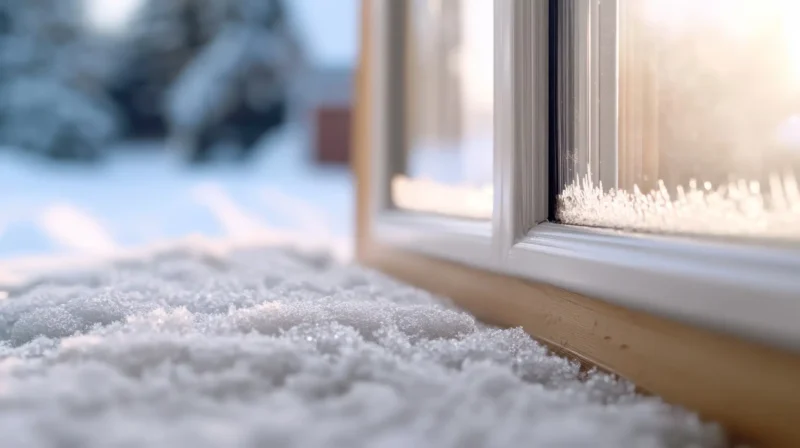As Boston braces for another winter, it’s time for homeowners to prepare for the city’s trademark cold season. The winters in Boston can be pretty intense. With temperatures often dipping below freezing, an average of 49 inches of snow piling up each year, and the occasional northeaster blowing through. That’s why it’s crucial to get your home ready, especially when it comes to your windows.
Drafty windows can lead to skyrocketing heating bills and chilly indoor spaces, making it essential to take proactive steps before the cold sets in. One of the most effective ways to keep your living space warm is to winterize windows. While it sounds like a daunting task, winterizing windows is quite straightforward with the right approach.
This guide offers simple, practical tips that anyone can use to get their windows ready for the harsh Boston winter. These easy steps will make a significant difference in your home’s comfort level when the temperature drops. By taking the time to prepare now, you’ll be able to enjoy a warm, snug home throughout the cold season, no matter what winter throws the way.
What Window Problems Can Winter Cause?
Boston in winter can be pretty tough on your windows if you don’t prepare them properly. You might face some uncomfortable and expensive problems. Here’s what could happen:
- Higher Heating Bills:
If your windows aren’t well-insulated, they’ll let heat escape, making your heating system work overtime. This leads to a significant increase in your energy costs.
- Chilly Drafts:
Cold air sneaking in through gaps around your windows can create uncomfortable drafts and make your whole house feel colder.
- Moisture and Condensation:
The big temperature difference between inside and outside can cause water to build up on your windows. This condensation might seem harmless, but over time, it can lead to mold growth, peeling paint, and even rot in your window sills and nearby walls.
- Frost on Windows:
When it gets really cold, moisture can freeze, forming frost on a window. It can cause the glass to expand and contract, potentially leading to cracks, and it can also harm the window frames and seals.
- Sticky Windows:
Cold temperatures can make window materials shrink a bit, sometimes making them hard to open or close. This isn’t just inconvenient – it can also be a safety issue if you need to open a window quickly in an emergency.
- UV Damage to Interior:
Even in winter, sunlight coming through unprotected windows can fade your furniture, carpets, and artwork. This UV damage can happen slowly, but over time, it can significantly affect the appearance and value of your belongings.
By taking care of these potential issues before the cold hits, you can make sure your Boston home stays cozy and energy-efficient all winter long. Plus, you’ll be protecting your windows and your belongings from damage that winter weather can cause over time.
Winterize Your Windows in 5 Steps
As the cold season approaches, it’s crucial to prepare your winter windows for Boston’s harsh weather. Here’s a simple guide to help you winterize your windows effectively:
- Deep Clean:
Start with a thorough cleaning. While you could do this yourself, hiring pros can make a big difference. Our team from Windows Cleaning Experts is well-prepared with the right tools and know-how to get your windows spotless. We offer various cleaning methods, depending on your needs – soft cleaning, pressure cleaning, power cleaning, etc. A clean window is your first defense against winter’s chill.
- Window Inspection:
Take a close look at your windows. Are there any cracks in the glass? How about gaps in the frame or worn-out weatherstripping? Catching these issues early can save you from bigger problems when the cold really sets in.
- Seal It Up:
Now it’s time to fix those problems you found. Use caulk to fill in any cracks or gaps around the window frame. If your weatherstripping is looking worse for wear, replace it. These small fixes can make a big difference in keeping out drafts.
- Add Extra Insulation:
There are a few ways of insulating windows with an extra layer of protection. Choose the right one for yourself:
- Weather Stripping: Great for movable parts of the window.
- Window Film: An easy-to-apply layer that adds insulation.
- Heavy Curtains or Cellular Shades: These trap air and provide extra insulation.
- Control Humidity:
Too much moisture in your home can lead to condensation on your windows, which can turn into frost when it’s really cold. Use a dehumidifier in damp areas and make sure your home is well-ventilated to keep humidity in check.
By following these steps, you’ll be all set for whatever winter throws at your windows. It might take a little time, but the comfort you’ll enjoy all winter long is well worth the effort!
Conclusion
Taking the time to winterize windows is a smart move for Boston homeowners. It’s not just about keeping your home snug during those freezing months – it’s also about saving money on your energy bills. By sealing up drafts, adding insulation, and controlling humidity, you’re creating a barrier against the harsh winter weather. This means your heating system won’t have to work as hard, which can lead to significant savings.
But remember, window care is a year-round job. Implementing a window maintenance routine throughout the seasons can prevent minor issues from becoming big problems when winter hits. So whether it’s a chilly January or a warm July, giving your windows some attention will pay off in the long run.
FAQ
- How to insulate windows for winter?
To insulate windows for winter, apply weatherstripping along edges and use caulk to seal cracks around frames. Install thick, insulated curtains or cellular shades, and consider applying window insulation film for an extra barrier against cold air.
- How to stop condensation on windows in winter?
To prevent condensation, improve air circulation with fans and reduce indoor humidity using a dehumidifier. Keep plants away from windows, close doors when cooking or bathing, and consider installing a hygrometer to monitor humidity levels in your home.
- How do you clean windows before winter?
Clean windows on a mild day using a cleaning solution or DIY, mixing equal parts water and white vinegar. Work in small sections, drying quickly to prevent streaking. Use a squeegee to remove excess water and dry thoroughly.




